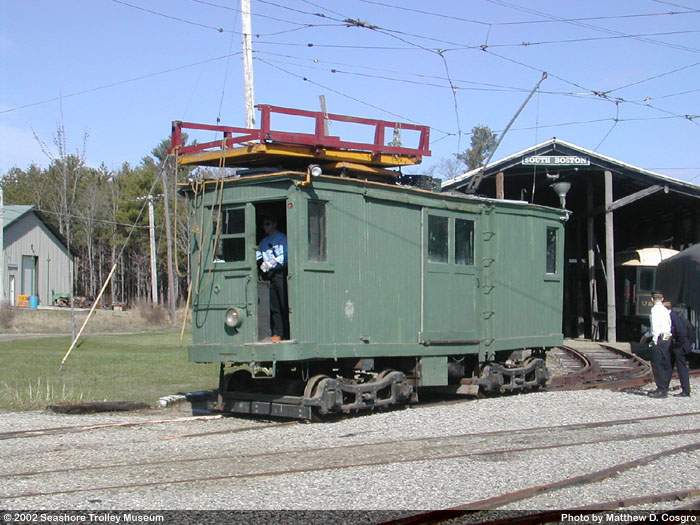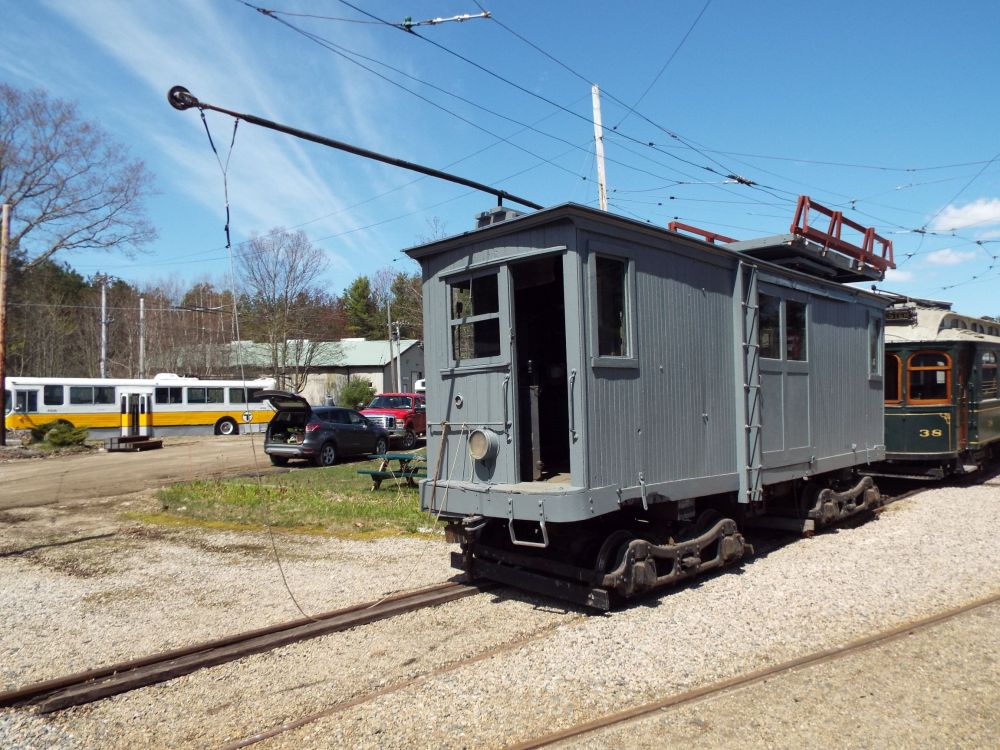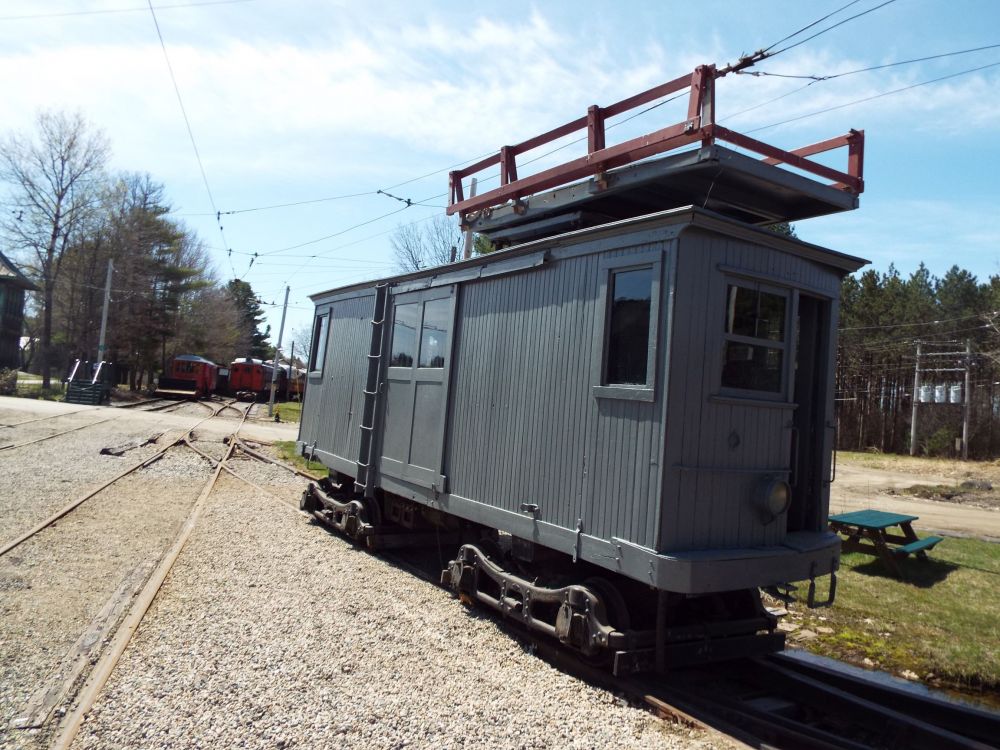
Matthew D. Cosgro In 2002
- Builder
- Laconia Car Co.
- Description
- Line car
- Secondary Use
- None
- Type
- Railway Work Equipment
- Year
- 1900
- Retired from Service
- 1954
- Acquired by the Museum
- 1955
- Note
- The car is the museum’s regular vehicle for repairing overhead wire.
Claremont Ry. 4
From Claremont, New Hampshire
History
The Claremont Railway & Lighting Co. began operation in 1903 with routes from Claremont, NH to West Claremont and to Claremont Junction. Besides passenger service, the CR&L provided freight service with a connection to the Boston & Maine Railroad at Claremont. At its peak, it operated 15 miles of electric lines around Claremont, NH. In 1919 the company was reorganized as the Claremont Railway. Passenger service ended in 1930. By the 1950s, it was New Hampshire’s last electric line. In 1954, the Claremont & Concord Railway bought the Claremont Railway as well as the Claremont to Concord, NH branch of the Boston & Maine Railroad. Electric operation ended in1954 at the time of the acquisition.
No. 4’s construction date is uncertain, but it is believed to have built by Laconia Car Company. The CR&L began passenger service in 1903 with three combination baggage and passenger cars. A 1945 article (and later book) by D.E. Shaw reports that soon after beginning operation, the CR&L acquired three open bench cars for summer service. One was wood, single truck, monitor roof, open car No. 4 which may have been acquired second-hand. Shaw quotes the line’s equipment maintainer, John Patch, remembering his rebuilding No. 4 into a line car, placing it on two arch bar trucks while retaining the same number. This rebuilding was done in two stages – first a conversion from an open bench passenger car to a line car soon after 1903 and a second rebuilding to lengthen the car and install a second truck. This lengthening was done after December 1930 when the Claremont Railway ended passenger service .
The C&RL originally identified its non-passenger equipment with letters instead of numbers. No. 4 may have initially been lettered “D.”
In 1955, the Claremont & Concord’s president, Samuel Pinsley, donated No. 4, without its trucks, to Seashore. The C&C scrapped No. 4’s arch-bar trucks. The Claremont & Concord also sent Claremont Ry. flat car No. 1 to Seashore. (Seashore later scrapped the flat car.) Seashore initially used the body of No. 4 as a storage shed. In 1959, the museum installed two type-5 trucks from a former Boston Elevated streetcar and used it for a limited amount of wire maintenance. However, the car did not operate well, and, in 1964, it went into storage.
On October 17, 1969, Boston’s MBTA damaged its line car No. 3283 in a lethal collision with motor flat No. 2026. (Both No. 3283 and No. 2026 later came to Seashore, but No. 3283 is now at the Shelburne Falls Trolley Museum.) The MBTA needed a replacement line car to maintain overhead wire on the Green Line while No. 3283 was being repaired. So, Seashore leased No. 4 to the MBTA as a replacement, believed to be the first time a museum vehicle moved back to regular operation. Only six days after the accident, No. 4 was at the MBTA’s Everett shops, a sign of the close working relationship between the MBTA and the museum. During three weeks at the Everett shops, the MBTA extensively modified No. 4. The MBTA installed a fixed roof platform, flood lights on the roof, new side doors and a new wire reel mounted inside. The MBTA painted the car gray with “T” symbols while retaining the number “4.” After repairing its regular wire car, the MBTA returned No. 4 to the museum in December 1970.
In 1974, Seashore replaced the MBTA’s fixed roof platform with a hoisting platform from Portsmouth Dover & York No. 108, and, in 1975, Seashore installed a swinging tower. In September 1975, Seashore again loaned No. 4 to the MBTA to help speed up conversion of the Green Line for pantograph operation. In compensation, the MBTA rebuilt the traction motors in Seashore’s line car S-71. The MBTA repainted the car in its yellow work car scheme. No. 4 returned to Seashore in January 1979. Before its service in Boston, Seashore had painted No. 4 silver and later brown. In 1989, Seashore painted No. 4 in a dark green Claremont Ry. scheme. In 2017, Seashore did extensive repairs on No. 4 and painted it gray. During this rebuilding, Seashore’s Restoration Shop found evidence of the frame of the original open car as well as the later lengthening.
Technical Information
- Control: K-12
- Brakes: Straight Air
- Compressor: DH-16
Trucks
- Number: 2
- Manufacturer: Standard
- Model: C-35P
Motor
- Number: 2
- Manufacturer: Westinghouse
- Model: 508A
Weight and Dimensions
- Length: 27’
- Width: 6’ 8.00"
- Height: 13’ 7.00"
Additional Images

Kenyon F. Karl on 05/08/19

Kenyon F. Karl on 05/08/19

Car on loan to MBTA in Green Line subway – Paul Kehoe in Apr 1970
© 1998 - 2026 New England Electric Railway Historical Society. All Rights Reserved.